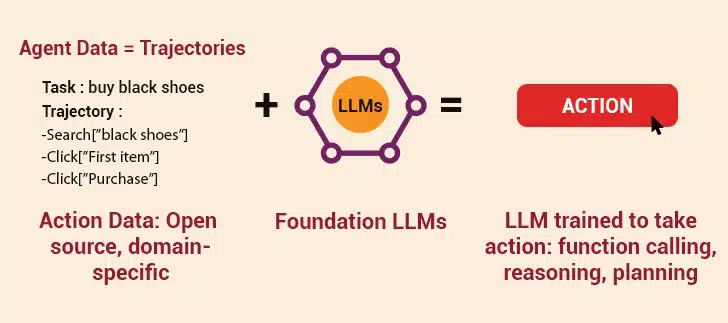Sales teams spend nearly two-thirds of their time on tasks that don’t actually bring in customers (or prospects). With back-to-back meetings and managing complex pipelines, life became difficult for sales reps….until the last quarter of 2024, when Salesforce dropped an update inside their Sales Cloud. As a torchbearer of AI advancements in recent times, it was always a matter of time that their think tank addressed the pain points and came up with a solution that actually worked.
Salesforce launched two new AI-powered models built on the Sales Cloud platform—xGen-Sales and xLAM. They take care of routine sales work so that your sales reps can focus on building lasting relationships with clients. For example, what if sales reps could get a summary of their sales calls within their Salesforce UI? The Salesforce AI Research team cooked up something interesting and useful in their labs, powering their Sales Cloud with Gen AI capabilities to simplify day-to-day sales tasks. Let’s break down what xGen-Sales and xLAM bring to the table for enterprises. Along the way, we’ll also see how they differ from each other. Let’s begin.
Table of Contents
XGen-Sales Salesforce: A Quick Rundown
xGen-Sales is a propriety AI model designed to help enterprises manage sales activities. It is made from advanced Large Language Models (LLMs) with humanized learning plus vast datasets from multiple sources. This model combines AI and data to make selling simpler and faster on a high level. It also helps sales teams better understand customer needs, track deals, and close sales more efficiently. The best part of xGen-Sales is that it works on any device, so sales reps can use it anywhere they want. Long story short, the xGen-Sales Salesforce model is an AI assistant for sales teams. It uses the power of Salesforce data and CRM features to save time, improve customer conversations, and boost sales. For example, you can use Einstein to summarize important information from a client call quickly. In fact, you can also use Einstein to identify key takeaways and customer sentiment.
What Is the xLAM Model in Salesforce?
xLAM model essentially refers to Salesforce’s family of Large Action Models (LAMs) specifically designed to enhance sales and broader business automation by enabling AI to perform complex tasks autonomously. Unlike traditional LLMs, these models specialize in function calling, reasoning, and planning to execute actions within software systems without having to lift a finger. For example, imagine asking an AI agent to write an email to a customer who’s having trouble logging into their account. Furthermore, xLAM models are designed to be cost-effective, faster, and more accurate than larger, more complex models that are currently available in the market. Below is a representation of how xLAM is basically an extension of LLM models.
How xGen-Sales and xLAM Models Are Different?
While both of these are AI models (or a family of models) built inside Salesforce, they serve different purposes. Here’s how.
| Aspect | xGen-Sales | xLAM (Large Action Models) |
|---|---|---|
| Purpose | LLM-based AI model specifically tailored for sales teams to get basic tasks done and improve productivity | Family of Large Action Models (LAMs) designed for sales teams to autonomously handle complex sales tasks |
| Primary Use Cases |
|
|
| Key Features |
|
|
| Integration | Integrated into the Agentforce and Sales Cloud | Part of the core Salesforce AI ecosystem which integrates across all Salesforce platforms and datasets |
| Model Sizes & Parameters | Not explicitly detailed; described as a finely tuned proprietary sales LLM | Multiple sizes available:
|
| Performance & Efficiency | Better than other options in the market especially for summarizing sales calls and other automated sales tasks | Outperforms GPT-4 and other major models on function calling despite a smaller size, and high accuracy in decision-making |
| Autonomy & Agent Support | Powers autonomous sales agents in Agentforce for nurturing pipeline and training sales reps | Powers multi-agent systems enabling collaborative autonomous agents to handle complex tasks and workflows |
| Data Security & Trust | Built in-house by Salesforce ensuring data remains secure within the Salesforce ecosystem, emphasizing trust | Developed in-house with a focus on accuracy and trust, crucial for updating critical data and executing precise actions |
| Model Type | Large Language Model (LLM) | Large Action Model (LAM) |
What to Expect When You Leverage These AI Models?
The ultimate goal of the two AI models is to empower your sales teams to work smarter. Here’s how in detail.
Benefits of X-Gen Sales Models
The XGen-Sales helps sales teams manage their tasks more smartly. Let’s see how it improves customer conversations, boosts sales, and makes the whole process smoother for everyone involved.
1. Improved Sales Accuracy
The xGen-Sales model helps reduce mistakes in the sales process. It keeps customer records clean and relevant automatically. The system also checks for errors in orders, prices, and customer details before they cause problems. This means fewer misunderstandings and happier clients. Accurate data also helps managers make better decisions about sales strategies. Not to mention, teams spend less time fixing errors and more time closing deals.
2. Personalized Customer Engagement
This model helps businesses understand what each customer really needs. It remembers past purchases and conversations to make interactions more meaningful. This helps sales teams get relevant suggestions about what to offer based on individual preferences. Moreover, customers feel valued because every message feels made just for them. The system also makes it easy to build stronger relationships without extra work. This personal touch leads to better experiences and more successful sales conversations.
3. Enhanced Decision-Making
The model provides sales teams with quick access to important information when they need it. It analyzes customer data and market trends to highlight key insights immediately. This allows managers to see which deals need attention or which strategies are working best. Furthermore, there’s no waiting for reports or digging through spreadsheets. As a result, decisions get made faster because the facts are clear and up to date. Teams can also respond to opportunities or problems right away instead of falling behind.
How to Build and Deploy Your First AI Agent Using Agentforce
Benefits of the xLAM Sales Model
xLAM simplifies complicated sales processes. Companies using xLAM have seen real improvements in their daily sales operations. Let’s look at some of its benefits in detail.
I. Enhanced Sales Efficiency
The xLAM model helps salespeople work smarter by cutting out wasted time. It organizes workloads, prioritizes important tasks, and removes unnecessary steps. The system finds quicker ways to complete routine jobs without sacrificing quality. This allows sales teams to get more done in less time because the model streamlines their daily work. It also learns from past actions to suggest better ways to operate. This constant improvement means businesses can serve more customers without adding extra staff or hours.
II. Reduced Operational Costs
Salesforce’s xLAM model helps businesses save money while working faster. It completes tasks that usually require multiple tools or people, cutting operational costs. The system processes information quickly without slowing down, even with large amounts of data. It also reduces the need for extra staff or expensive software by handling complex jobs automatically. This helps companies get better results in less time while spending less on resources.
III. Better Scalability Across Business Functions
The xLAM model grows with your business needs without losing efficiency. It handles increasing workloads across different departments smoothly. This helps teams ensure consistent performance even during busy periods. Whether you’re adding more customers, products, or services, the system adapts easily. This flexibility means companies don’t need separate solutions for different areas. Everything works together seamlessly as operations expand, keeping workflows simple and manageable at any size.
IV. Increased Adaptability to Real-World Enterprise Needs
The xLAM model adjusts to how businesses operate every day. It learns company processes and workflows instead of forcing teams to change how they work. The system handles different departments’ unique requirements without needing special setups. As business needs evolve, the model adapts automatically to new situations. It works with existing tools rather than replacing everything at once. This flexibility makes adoption smoother since employees can keep working normally while the model supports them.
How to Boost Your Sales Strategy with Salesforce AI
Ending Note
Salesforce’s xGen-Sales and xLAM models are changing how businesses sell products and connect with customers. These AI tools help sales teams work smarter by predicting what customers need, suggesting the best actions, and handling routine tasks automatically. The real power of these models lies in their ability to learn and improve over time, making sales processes faster and easier. If you also want to adopt these AI sales enablement tools to make sales less about pushing products and more about delivering the right solutions at the right time, you may seek consultation from a registered Salesforce partner.







